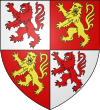County of Armagnac
| County of Armagnac Comté d'Armagnac | |||||||||||
|---|---|---|---|---|---|---|---|---|---|---|---|
| Before 960–1790 | |||||||||||
|
Coat of Arms before 1304 on left, and after 1304 on right. | |||||||||||
| Capital | King of France (from then) | | |||||||||
• c. 950–961 | Sancho V Sánchez of Gascony | ||||||||||
• 1422–1453 | King Henry VI of England | ||||||||||
• 1453–1461 | King Charles VII of France | ||||||||||
• 1774–1790 | King Louis XVI | ||||||||||
| Count of Armagnac | |||||||||||
• ?–960 | William Garcés of Fézensac | ||||||||||
• 1718–1751 | Charles de Lorraine | ||||||||||
| Historical era | Early modern period | ||||||||||
• County created | Before 960 | ||||||||||
• Decree dividing France into departments | 1790 | ||||||||||
| |||||||||||
The County of Armagnac (
History
Under Roman rule, Armagnac was included in the Civitas Ausciorum, or district of
The three great territorial lords in the south were the
During the
In 1410 the daughter of Count Bernard VII of Armagnac (d. 1418) was married to Duke
After peace was established, many veterans originally recruited by Count Bernard VII formed mercenary bands that also became known as the Armagnacs. Although they were in the service of King Charles VII, the Armagnacs became notorious for their rapacious plundering in the north of France. In 1444 they were sent to Switzerland on an expedition known as the Armagnac War, which culminated in a battle between the Swiss and the Armagnac mercenaries on August 26, 1444. Although the Swiss were badly defeated, their determined resistance persuaded the Armagnacs to withdraw from Switzerland. Soon after, the Armagnacs were incorporated into Charles VII's regular army.
After the death of Bernard VII in 1418, the counts of Armagnac gradually lost their powerful position in southern France. In the late fifteenth century
Government
During the 17th and 18th centuries, the County of Armagnac was an
Following the decree dividing France into departments announced on 22 December 1789, the County of Armagnac was disestablished. The majority of the county formed part of the new Department of Gers, while the far western parts became part of Landes.[6][7]
List of counts
Geography
The region is watered by several small rivers that descend from the Lannemezan plateau; the river Gers is the largest of these. The region is centered at approximately 43°40'N 0°12'E (43.7, 0.2).
Footnotes
Notes
Citations
- ^ "Armagnac". The American Heritage Dictionary of the English Language (5th ed.). HarperCollins. Retrieved 7 May 2019.
- ^ "Armagnac". Merriam-Webster.com Dictionary. Retrieved 7 May 2019.
- ^ The elder branch of the Armagnac line failed to produce a male heir in 1245, so that the two lines were rejoined in the person of Géraud V, comte de Fezansaguet, confirmed as comte d'Armagnac in 1256; however, at his death (1285) the two counties were separated anew.
- ^ "Armagnac | historical region, France | Britannica". www.britannica.com. Retrieved 2021-11-29.
- ^ "Gascony | historical region, France | Britannica". www.britannica.com. Retrieved 2021-11-29.
- ^ Suite des décrets sur la division du royaume du 28 janvier 1790 archive, Département d'Armagnac.
- ^ Suite des décrets sur la division du royaume du 15 février 1790 archive, Département des Landes et Chalosse.
Bibliography
- The Encyclopedia Americana, 1977
External links
- Stories about the region (in French)


